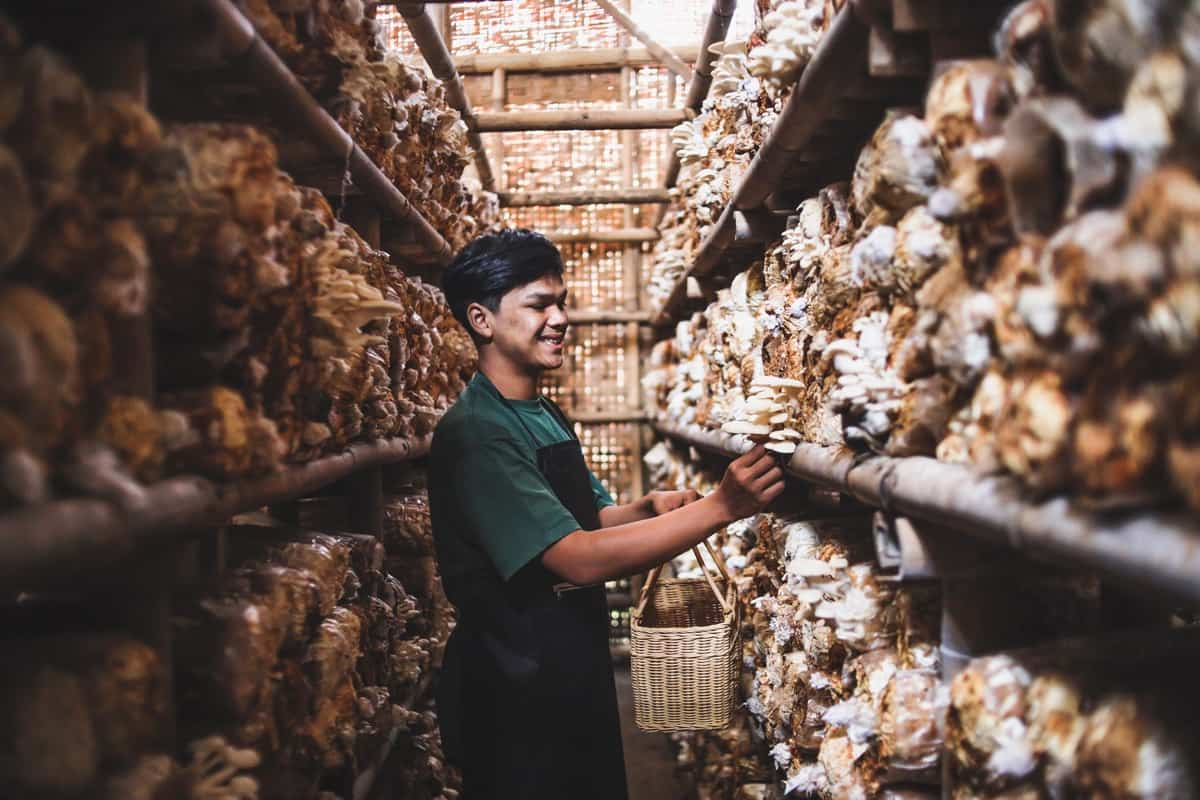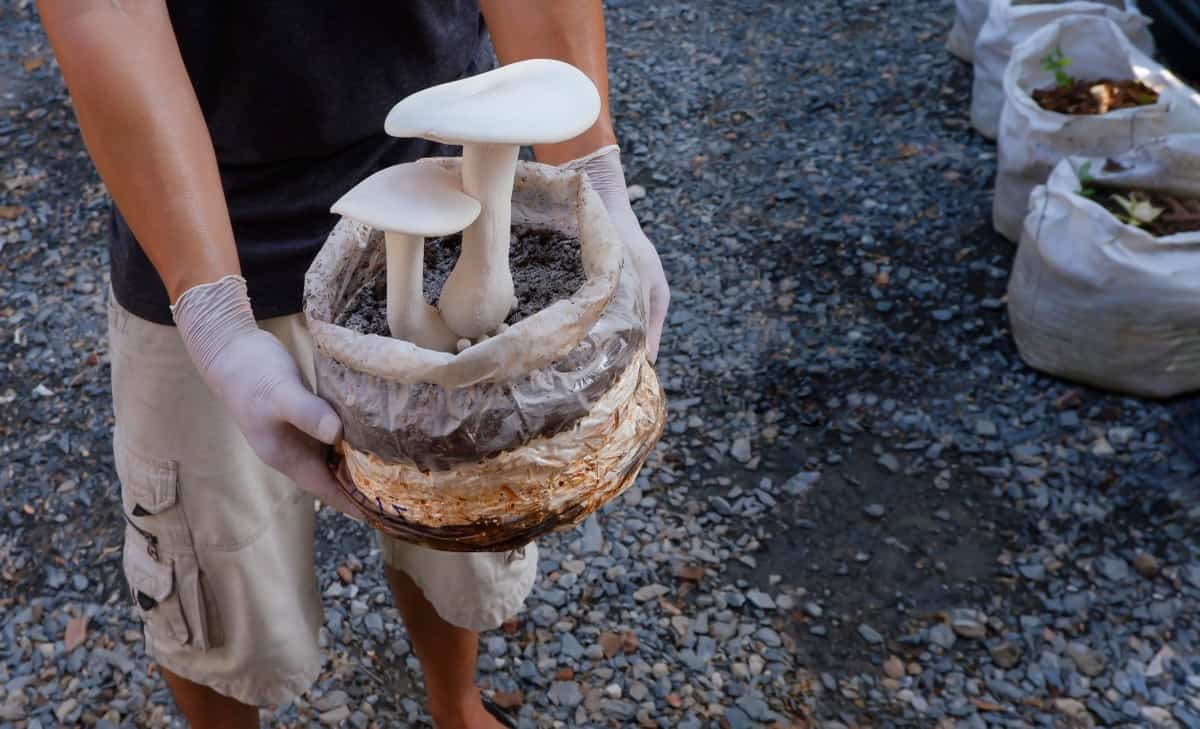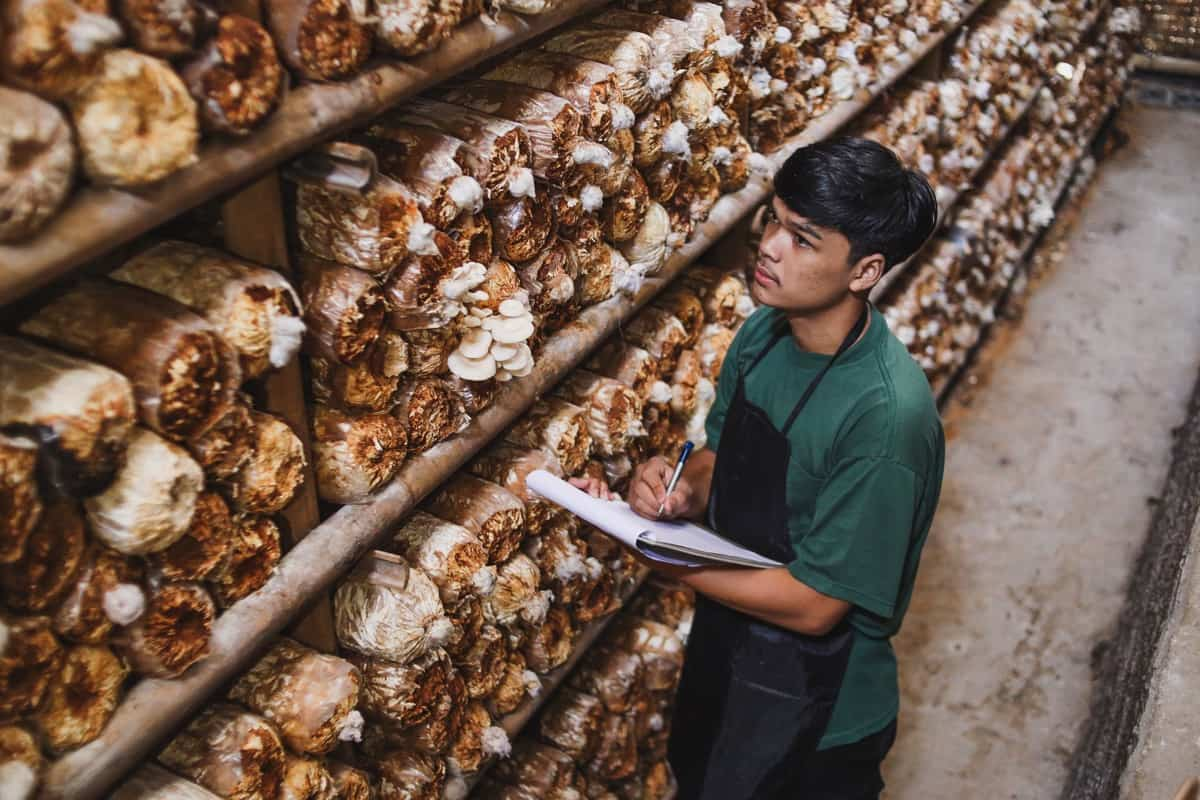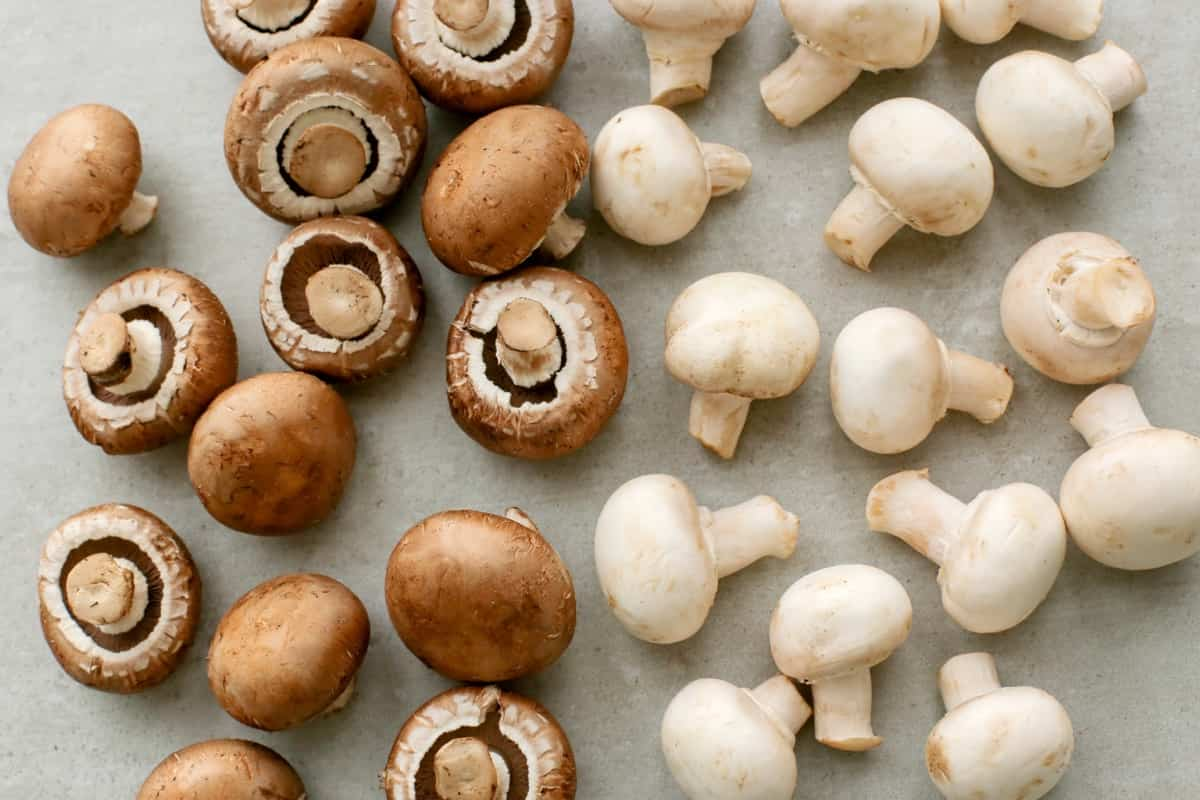Growing mushrooms at home can be a fun and fulfilling activity, but one question that often comes to mind is, how long does it take to grow? The answer isn’t as straightforward as one might think. Factors such as temperature, the type of mushroom species you’re growing, and even sterilization techniques are crucial in determining the growth rate. Whether you’re a beginner wondering about oyster mushroom growth stages or a seasoned mycologist curious about how long it takes for mycelium to grow on grain.

Understanding the nuances can help you set realistic expectations and troubleshoot problems, like why your mushrooms are not growing after two months. This article will dive deep into what factors affect the growth of mushrooms, how to grow mushrooms efficiently, and even touch upon how long it takes for a wild mushroom to grow and how long it takes to grow mushrooms from spore.
How Long It Takes to Grow Mushrooms at Home
Understanding the Mushroom Growth Cycle
When you embark on the journey of home mushroom cultivation, it’s crucial to understand the mushroom growth cycle to manage your expectations. The process starts with spores, which eventually form mycelium, the vegetative part of the fungus. This mycelium grows on a substrate, such as grain or wood chips, and it’s during this stage that you may wonder how long it takes for mycelium to grow on grain. Usually, this stage takes around one to three weeks, depending on different factors.
Once the mycelium has colonized the substrate, the conditions are altered to initiate the fruiting stage. This is where you’ll see actual mushrooms start to form, and this stage can take another one to two weeks. Some mushrooms, like oyster mushrooms, have distinct growth stages, often referred to as oyster mushroom growth stages, which can help you estimate the time it will take for them to reach maturity.
Factors Affecting the Growth Rate of Mushrooms: Exploring the Key Variables
Various factors, such as the environment and substrate choice, can impact how quickly your mushrooms grow. Questions like, why are my mushrooms not growing after two months, often arise when one or more of these factors are not optimized. In such cases, revisiting your cultivation techniques to identify the bottlenecks is important.
The choice of substrate, for instance, is critical; different types of mushrooms prefer different kinds of organic matter. Water content in the substrate, fresh air exchange, and light exposure are other variables that need careful monitoring. Ignoring these factors can result in stalled growth. Thus, aligning every variable to your specific mushroom’s needs is critical for optimal results.
In case you missed it: How to Use 19-19-19 Fertilizer in Your Garden: Benefits and When to Apply

The Role of Temperature in Mushroom Cultivation: Optimal Conditions for Faster Growth
Temperature is pivotal in mushroom cultivation, impacting every stage of the mushroom life cycle. Too cold or too hot, and the mycelium may not colonize the substrate, or the mushrooms may not fruit. Generally, mycelium prefers slightly warmer conditions for growth, usually around 75-80 degrees Fahrenheit.
A slightly cooler temperature is preferred once you switch to the fruiting stage. It’s worth investing in a good thermometer to monitor temperatures consistently. The right temperature settings can make a significant difference, helping answer the common question of how long it takes for a mushroom to grow from mold, as molds are usually an unwanted consequence of suboptimal conditions.
Choosing the Right Mushroom Species for Quick and Efficient Home Cultivation
If you’re particularly impatient and are looking for quick results, your choice of mushroom species is paramount. Some species are faster to cultivate than others, answering the general query about how long it takes for a wild mushroom to grow. For example, oyster mushrooms are known to grow quickly and are relatively forgiving in terms of growing conditions, making them ideal for beginners.
On the other hand, other species might take longer but offer different flavors, textures, or medicinal properties. The time it takes for a mushroom to grow from spore can vary greatly, with some species ready to harvest in just a few weeks, while others may take months. Therefore, make sure you choose a species that aligns with your level of experience and your patience.
The Importance of Proper Sterilization Techniques in Accelerating Mushroom Growth
Using the right sterilization methods can really speed up how fast your mushrooms grow. It’s important to sterilize the stuff you use to grow them, like the soil and tools, so that harmful bacteria and molds don’t grow instead. Any contamination can not only slow down the growth of your mushrooms but also spoil the entire batch. This is particularly vital during the initial stages when the spores germinate.
The aim is to create a sterile environment for the mycelium to grow, thus reducing the chances of asking why my mushrooms are not growing after two months due to contamination. Sterilization techniques like pressure cooking substrates or using isopropyl alcohol for tools can go a long way in ensuring that you achieve healthy and fast-growing mushrooms.
Nutritional Requirements for Mushrooms: Providing the Ideal Substrate for Rapid Development
One of the most critical aspects of mushroom cultivation is selecting the proper nutritional base that promotes rapid and healthy growth. This substrate is what the mycelium, the vegetative part of the mushroom, feeds on to develop fully. A commonly used substrate is a mixture of organic matter like straw, wood chips, or grain, depending on the mushroom species you’re cultivating.
In case you missed it: Top 15 Strawberry Varieties to Grow in Your Garden: Best List of Strawberry Varieties for High Profits

Nutritional adequacy is essential because sub-optimal substrates can slow growth, sometimes leading to questions like why my mushrooms are not growing after two months. For instance, oyster mushrooms thrive on straw-based substrates, while other species might prefer wood chips or grain. Correcting the substrate’s nutritional profile is vital for a quicker development phase and a bountiful harvest, ensuring that your mushroom-growing efforts are fruitful in the shortest time possible.
Light Exposure and Its Impact on Mushroom Growth: Finding the Balance
Light exposure is another crucial variable in mushroom cultivation that often gets overlooked. While mushrooms are not plants and don’t photosynthesize, they still require a certain amount of light to trigger the fruiting process. However, it’s essential to strike a balance, as too much light can lead to drying out, while insufficient light might result in spindly, underdeveloped fungi.
Light exposure also influences the direction in which mushrooms grow, affecting their overall form and appearance. Ideally, indirect light for a few hours a day is recommended for most species. Understanding how to control light conditions can greatly impact the time it takes for a mushroom to grow from mold. This is particularly important because molds usually thrive in damp, dim environments that aren’t ideal for mushrooms to grow.
Humidity Control in Mushroom Cultivation: Creating an Environment Conducive to Growth
Maintaining the right level of humidity is another pillar in effective mushroom cultivation. A controlled, high-humidity environment encourages mycelium to develop and helps in the mushroom fruiting process. Lack of sufficient humidity can lead to poor cap development and decreased overall yield.
Many growers use specialized humidifiers, misting systems, or even manual spraying to maintain an ideal humidity level, usually above 90% for most species during the fruiting stage. Achieving the perfect humidity level is crucial for creating an environment conducive to growth. It can significantly influence how long mycelium grows on grain or any other chosen substrate.
Understanding Mycelium Colonization: The Initial Stage of Mushroom Development
The foundation of successful mushroom cultivation is the effective colonization of mycelium on the chosen substrate. In this initial stage, the spores germinate and grow into a network of mycelium, preparing for the fruiting stage. How long it takes for the mycelium to grow on grain or another substrate depends on various factors like temperature, humidity, and the nutritional quality of the substrate.
In case you missed it: 15 Best Apple Picking Orchards in New Jersey: Top List for Apple Picking Farms in NJ

It’s essential to monitor for any signs of contamination, as foreign bacteria or molds can outcompete the mycelium, leading to a failed crop. If everything is optimal, mycelium colonization can take one to three weeks, setting the stage for the next phases in the mushroom life cycle.
Spawning and Fruiting: How Long Does It Take for Mushrooms to Appear?
After fully colonizing the substrate with mycelium, the next steps involve spawning and initiating the fruiting conditions. Spawning adds more substrate to the fully colonized initial substrate to increase the yield. After spawning, changes in environmental factors like light exposure and temperature signal the mycelium to start the fruiting process. This is the stage where you’ll see tiny mushroom pins forming, eventually developing into full-grown mushrooms. Generally, it can take one to two weeks for mushrooms to appear and reach maturity for harvesting.
Harvesting Mushrooms at the Right Time: Maximizing Yield and Quality
The final stage of mushroom cultivation is harvesting, which is equally important for maximizing yield and quality. Timing is crucial; harvesting too early may result in underdeveloped mushrooms while waiting too long could lead to overripe mushrooms that are less flavorful and have a lower nutritional profile. Generally, the right time to harvest is just before the mushroom caps fully uncurl.
For some species, like oyster mushrooms, the ideal time is when the edges of the caps start to turn upwards. Properly timed harvesting not only maximizes yield but also ensures you’re getting the best quality mushrooms, completing the cycle of growth that began with spore germination and mycelium colonization.
Common Challenges and Troubleshooting Tips for Faster Mushroom Growth
Growing mushrooms at home can be a gratifying experience, but like any form of cultivation, it comes with challenges that may affect how long it takes to grow. One frequent issue is contamination, often manifested as mold growth, which can stall or completely ruin your mushroom crop. Another common challenge is stalled mycelium growth, leading to questions like why my mushrooms are not growing after 2 months. This problem could be due to inadequate nutritional content in the substrate or less-than-optimal environmental conditions.
Furthermore, uneven or insufficient moisture levels can also lead to poor development and lower yields. It’s essential to continuously monitor your set-up and make adjustments as needed for troubleshooting. Regularly inspect for signs of contamination and consider isolating affected areas or substrates. Also, ensure that temperature and humidity are kept at levels conducive to mushroom growth to foster rapid development.
In case you missed it: Top 15 Papaya Varieties to Grow in Your Garden: A Guide for Beginners

The Role of Fresh Air Exchange in Promoting Healthy Mushroom Development
One aspect of mushroom cultivation that is often under-emphasized is the importance of fresh air exchange (FAE). While high humidity and limited light exposure are required for mushroom growth, an environment with stagnant air can be detrimental. Insufficient fresh air can cause too much carbon dioxide and less oxygen, slowing down mycelium growth and stopping mushroom growth.
That’s why introducing regular fresh air exchange into your cultivation space is essential. Methods can range from manual fanning to using more sophisticated automated systems. Managing FAE correctly can significantly reduce the time it takes for a mushroom to grow from mold or spore, promoting healthy, vigorous mycelium and fruit bodies.
Enhancing Mushroom Growth with Supplemental CO2: Pros and Cons
Contrary to fresh air exchange, which aims to reduce excess CO2, there are instances where supplemental CO2 is considered beneficial for mushroom growth. This is particularly true during the initial mycelium colonization stage, where elevated CO2 levels can sometimes encourage quicker growth.
While elevated CO2 levels might speed up the initial mycelial growth, they are generally not recommended during the fruiting stage, as they can lead to long, leggy mushrooms with small caps. Also, managing CO2 levels requires precision, as excessive amounts can lead to an acidic environment that may hamper growth or invite contamination. Therefore, while supplemental CO2 might offer some advantages in specific cases, it’s essential to use this technique judiciously and understand its potential impact throughout the mushroom growth cycle.
Conclusion
You can cultivate healthy, fast-growing mushrooms at home by paying attention to these critical factors and diligently monitoring your growing conditions. Mushroom cultivation at home involves a multidimensional approach that integrates various factors, from selecting the ideal substrate for nutritional requirements to understanding the significance of light exposure, humidity control, and fresh air exchange.
In case you missed it: 20 Types of Lavender to Grow in Your Garden: Discover Lavender Main Types

Each of these variables plays a pivotal role in how long it takes for mushrooms to grow, develop from mold, and even how long it takes for mycelium to grow on grain or other substrates. Challenges like contamination or stalled growth can be tackled through proper sterilization and diligent monitoring, while the timing of harvesting ensures the yield is both abundant and high-quality. Techniques like supplemental CO2 injection have pros and cons, underscoring the need for nuanced understanding and application of cultivation strategies.
- Organic Gardening on a Budget: Low-Cost Methods and Materials
- Gongura Seed Germination and Planting Methods
- Cabbage Seed Germination and Selection
- Broccoli Seed Germination and Selection
- Asparagus Seed Germination and Variety Selection
- Seasonal Flower Gardening: Best Practices for Spring, Summer, Fall, and Winter
- How to Grow Hibiscus from Flower
- Plantation Ideas for Home Decoration: A Beginners Guide
- Flower Garden Designs and Layouts for Beginners
- Planting and Spacing Techniques in Papaya: A Beginner’s Guide
- Growing Gold: Essential Techniques for Planting Pineapples
- How to Make Kalanchoe Plant Bushy: Home Remedies and Solutions
- 11 Reasons Why Your Gardenia is Not Blooming: Home Remedies and Solutions
- Eco Elegance: The Guide to Designing a Drought-Tolerant Landscape
- Gardening on a Slope: Strategies for Hillside Landscaping
- Nourish and Flourish: Top Organic Mulches for Thriving House Plants
- Everything You Want to Know about Indian Mogra Flower: Discover Uses and Growing
- Green Thumb Success: Expert Tips for Cultivating Greenhouse Pumpkins All Year Round
- Maximize Growth & Flavor: The Ultimate Guide to Companion Planting in Herb Gardens
- How to Control Rhododendron Problems Naturally: Home Remedies and Organic Ways to Fix Them
- Natural Magic: The Remarkable Benefits of Cinnamon for Plants
- Best Steps to Revive Dying Tulip with Natural and Organic Treatment
- 10 Reasons Why Your Angel Trumpet is Not Blooming: Remedies and Treatment
- How to Fix Periwinkle Leaf and Flower-Related Problems: Natural Remedies and Solutions
- How to Fix Zinnias Leaf and Flower Problems: Discover Natural and Home Remedies
- Organic Steps to Induce Lemon Tree Flowers: A Comprehensive Guide
- Bloom Booster: Crafting the Perfect Homemade Bougainvillea Fertilizer
- Optimizing Growth: A Guide to Applying NPK Fertilizer for Potted Plants
- 10 Best Homemade Fertilizers for Rubber Plant: DIY Recipes and Application Method
- How to Boost Female Pumpkin Flowers: Effective Steps for More Flowers and High Yields
- Transform Your Indoor Garden: Top Benefits of Pink Salt for Houseplants
- 10 Best Homemade Fertilizers for Peacock Plants (Calathea): Easy DIY Guide
- Unlock Blooms: 9 Reasons Why Your Potted Chrysanthemum is Not Blooming
- 8 Reasons Why Your Potted Hibiscus is Not Blooming: Fix it with Simple Solutions
- Unlock Blooms: 9 Key Reasons Your Potted Frangipani Won’t Flower
- 10 Reasons Why Is My Ice Plant Not Blooming: Remedies and Treatment